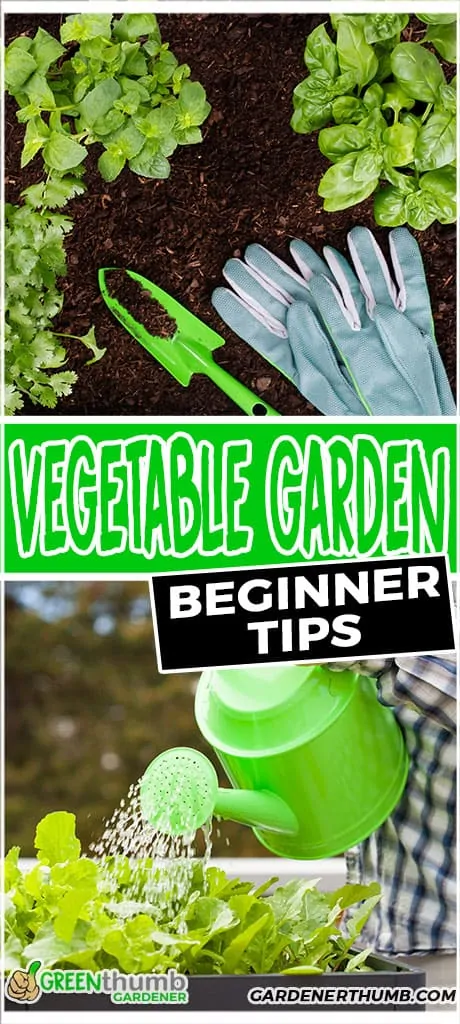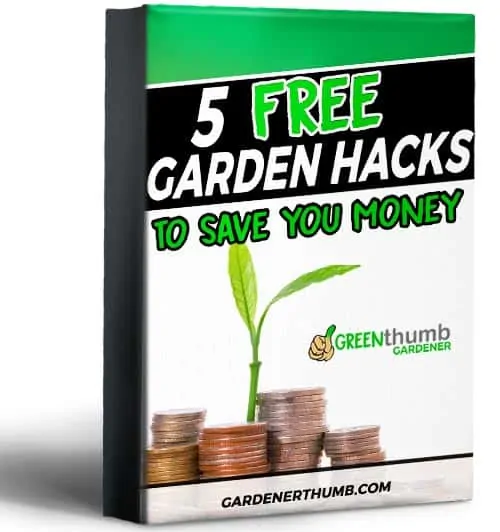Vegetable Gardening Tips For Beginners
Last updated: 10/5/20
When I started gardening, it was a real mess. I had no idea what to do and guess what happened? My vegetables began growing with no support, I had weak plants, and so many other issues!
And to top it all, I got the most frustrating harvest ever.
Gardening is my passion, so I knew I had to do everything I could to improve.
Gradually, I began learning vegetable garden tips for beginners. Now, I am happy with my harvest.
Green thumb Gardener occasionally links to product and/or services offered by vendors to assist you with all your gardening needs. Some of these may be affiliate links, meaning we earn a small commission if items are purchased.
Want to Download a Garden Hack Guide for FREE
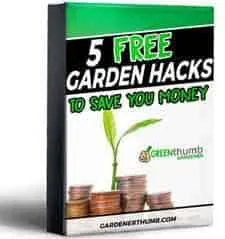
Enter your email below and we will send you a guide to help you SAVE money in your garden.
20 Gardening Tips For Beginners
1. Choose The Ideal Location
This takes the top priority for any beginner in gardening. If you plan on planting vegetables, you’ll need to decide on the best location for your vegetable garden.
The ideal location provides optimum gardening conditions and meets all the requirements of your vegetables. Some of the factors that you will need to consider include:
Sun Coverage
The perfect spot for your vegetables is one with sun coverage throughout the day.
For your vegetables to thrive in outdoor spaces, they need sunlight for at least 10 hours a day. The sun’s rays aid photosynthesis in plants.
Availability Of Water
Your vegetable garden needs regular watering, especially when there is not a lot of rain in your area. Choose a location that will provide easy access to water.
Water is the basis of all plantations, apart from keeping your vegetables buoyant and fresh, it facilitates the plant’s intake of nutrients and leads to a better harvest.
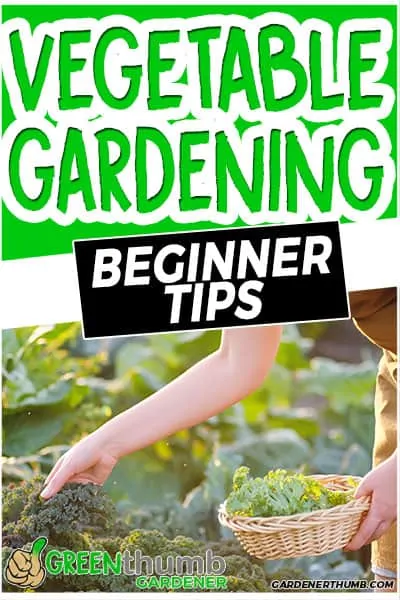
How Close Is Your Vegetable Garden?
Planting vegetables closer to your home will encourage you to dedicate more time to caring for the plantation.
Whenever you’re free, you will find yourself weeding or watering your vegetables.
Beyond that, regular weeding for your vegetables boosts surplus yields.
2. The Top 3 Easiest Vegetables To Start
To make your first experience in gardening enjoyable, start with easy vegetables. Later, you can add more vegetables to your list.
Carrots
These are probably the easiest vegetables to plant. You’ll need to prepare the garden soil by clearing all weeds and tilling.
Cucumbers
Either the pickling or the slicing type of cucumbers, they are easy to grow. With cucumbers, planting them is easy, and they are perfect for any beginner.
Beets
These are tasty vegetables that don’t occupy much room when growing. If you have a spacious garden area, then growing beets is your perfect fit.
Check out this video on growing beets in containers:
3. Keep A Gardening Journal
Keeping a journal helps you document your gardening activities. Furthermore, it allows any gardener to learn from their past experiences.
There are many other benefits to owning a gardening journal.
As a beginner, keeping a record of the plants you grow and how well they thrive in your garden will help you decide the best vegetables to plant in your garden.
It will keep track of your gardening progress.
Furthermore, writing a gardening journal is essential for the improvement of any beginner in gardening and will help you grow from a beginner to a real expert in gardening.
4. Pick Vegetables Suitable For Your Area
Some vegetables thrive better in certain areas than others. For instance, kale thrives well in cold regions, but turns bitter when planted in hot areas.
Moreover, lettuce grows better in the early spring season.
Most vegetables will flower earlier than usual when planted in a hot area, which changes their flavor.
Before taking your pick on which vegetables to plant in your garden, it’s essential to understand the time they take to mature.
The growing season in your area should be long enough to allow your vegetables to grow to maturity.
If you live in the US, you can check your growing zone here.
As a beginner, you’ll need to decide whether you need vegetables for a season or a whole year.
5. Enhance The Weed Control Measures
You have to know precisely when to weed and how to weed to control the garden weeds.
Most beginners make the mistake of not weeding correctly. Like the whole gardening process, weeding is just another skill you have to learn with time and practice.
Furthermore, it would help if you had proper timing when you do your weeding. Doing it once a week will keep your garden clear.
Mulching is one of the perfect ways to help you reduce weeds in your plantation. For beginners in vegetable gardening, this is an easy way to keep your vegetables free of weeds with just your effort, no cost incurred!
Additionally, mulching will help retain moisture, so you’ll need to water your vegetables less often.
Moreover, planting your vegetables closer will help reduce the weeds sprouting from the ground.
6. Boost Your Soil Health
To have a great vegetable harvest, you’ll need to plant them on healthy soil. Improving your soil is the key to more nutritious vegetables.
It’s a fact that healthy soil equals successful gardening. You have to determine the best time to prepare the soil.
Use efficient garden tools to clear your garden before planting the vegetables.
The best vegetable soil is dark and rich in nutrients. If your soil is lacking in these things, don’t panic, there is a way to make it better – all you need to do is to add compost to your soil.
Organic matter helps bridge the large gaps between sandy soil, thus allowing it to retain water and nutrients.
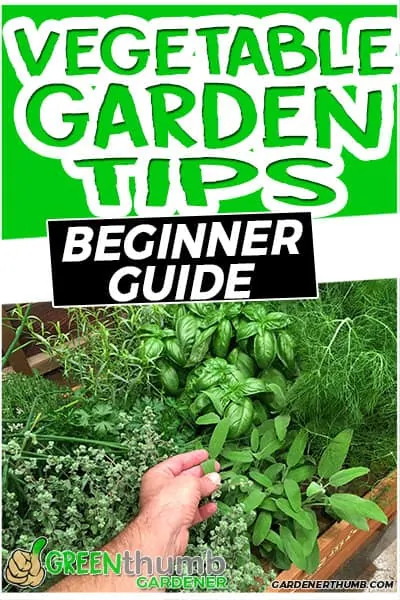
Furthermore, it separates the compact, clay particles allowing the water and nutrients to pass through.
Through this process, you can quickly curb drainage issues in your garden.
The best thing is that if you need to supplement your soil, you can create compost yourself.
7. Choose Your Favorite Vegetables
Most beginners start with vegetables they don’t really like eating. This mistake leads to a waste of time and yields.
You can’t dedicate most of your time to your vegetables if neither you nor your family likes eating them. Besides, you’ll have a hard time when deciding on whether to harvest them or not.
8. Plant The Right Amount
Before you begin planting it’s best to determine the amount you want to start with.
The number of vegetables you plant should ideally be equal to the amount your family uses. You should know the number of vegetables for every person in your family.
And further, you need to know how you’ll preserve the vegetables after harvesting.
Most beginners in vegetable gardening often plant more than they can consume, leading to waste.
9. Decide On The Method Of Irrigation
Watering is essential for plant growth, and just like any other plant, your vegetables need water. This makes the soil moist, and as a result, plants can absorb nutrients efficiently.
You’ll need to understand the best practices in watering your vegetables, when, and how you should do it in order to maintain an evergreen and lively garden.
Adopting an irrigation method that keeps your roots moist helps in avoiding frequent watering during the dry season.
Watering needs a convenient irrigation system.
10. Container Gardening Is The Way
If you are looking for an easier way to plant your vegetables without much weeding, then containers are what you should consider.
Although you will have to provide your plants with water and fertilizers regularly, it is easier to plant in containers than in your flat garden.
If you are considering planting your vegetables in a smaller space, this planting mode will undoubtedly fit your needs.
Just like the raised beds, they will require less effort when weeding as compared to weeding in an open garden. You can even use containers for vegetables in a house you’re not planning on staying in for a long time.
There are many ways to grow vegetables in containers to fit your aesthetic.
11. Organize Early For Harvesting
Apart from the planning on planting and caring for the plants, you will have to plan on harvesting and storage before your vegetables are ready for harvest.
You will have a plan on how to preserve the vegetables. Some preservation methods include canning leftover vegetables.
12. Learn All About Fertilizers
Any gardener must understand which type of fertilizers are best suited for particular plants.
Some farmers have planted large yards only to harvest so little! Understanding the fertilizer requirement of your vegetables before planting them is vital in gardening.
Plants have diverse fertilizer needs for optimum growth.
While some vegetables thrive well when supplied with efficient nitrogen content, others reduce their produce when exposed to the same conditions.
13. Strong Seedlings To Start Off
If you buy your seedlings from a plant nursery, pick those with fresh, green leaves and healthy flowers and fruits.
Check if the seedlings are infested with pests or eggs on the leaves, indicating that they are more likely to develop at a slower rate.
Flowers and fruits on short plants indicate how a lack of optimum plant requirements are likely to delay before adapting to your garden, and they will certainly not do well.
While other people consider buying seedlings, others opt to plant vegetable seeds directly into the garden. You will need to research more about seeds and live plants before choosing which works best for you.
14. Vertical Gardening To Save Space
If you have a limited garden space or want to make your gardening fancier, vertical gardening is your best option.
There is a variety of vertical vegetables to include in your vegetation list. You won’t run short of choice.
Whether you plan on using hanging baskets, shelves, or trellis to keep your garden in style while accommodating more seedlings, you’ll need to check out your options to decide what the best fit will be for you.
There are many DIY and creative, vertical gardening ideas.
15. Consider Direct Seed Plantation
Indoor gardening is great for beginners in vegetable gardening, but let’s face it, it’s a total nightmare to some.
If you don’t prefer starting with indoor plants before transferring them to outer spaces, you can opt to sow seeds directly to your garden.
We all have our preferences, and that does not mean that the vegetables will not do well.
Besides, there are lots of vegetable varieties you can quickly grow from seeds. There are also several advantages associated with direct seed plantation.
Be sure to read up on whether to buy seeds or seedlings.
Prepare your garden and plant the seeds before the rains hit the ground. After a few days, the seeds sprout, and your garden turf is all green.
16. Keep The Garden Close
You are more likely to remember tending to your vegetables when you are closer to them.
Gardening in a spot where you like spending most of your time ensures that you can dedicate more time to your vegetables than if the garden was much further from your favorite site.
17. Start With A Small Garden
One of the drawbacks of being a beginner in gardening is that you’re never sure of your yard’s perfect size to plant vegetables.
If you are just starting to garden, consider starting small with expectations of expanding as you gain more gardening experience.
Try out a small-sized plot – just enough to feed your family.
Gardening needs lots of time. And a big garden will need more time than a small one.
If you start with a large garden, you might get frustrated due to the amount of time it demands.
With your small garden, plant a few varieties of vegetables. Wait, and see the outcome. Then, you’ll be sure of whether to maximize or minimize your garden size.
18. Proper Timing
Everything in gardening is about time, and that is all it takes to have a thriving vegetable plantation.
Before starting your vegetable garden, you’ll have to know the perfect time for every stage of gardening.
How long does it take your vegetables to mature? When is the best time of the year to plant a particular type of vegetable?
Clarity on the above questions is what makes a successful vegetable garden.
Using a vegetable gardening spreadsheet will help a lot in proper planning.
Moreover, you can decide to keep a record of all the seasons and when to plant your vegetables; Spring or early Summer, and so forth.
If you can access the map of your zone area, you’ll know what to plant and when to do it.
19. Plan Your Garden Layout
Decide on the layout you will adopt in your vegetable garden, whether a row or intensive cropping.
Row cropping
With this layout, vegetables are planted a few inches apart in a single row, just like its name suggests. It’s convenient for large fields and does well with vining vegetables such as cucumbers.
This cropping method is advantageous because it allows for movements between the vegetables when using farming equipment and weeding. Its drawback is that more space is left unused.
Intensive cropping
This method involves planting vegetables close together so there is barely any space left between them when they mature. This method works great with other vegetable types except for vining ones.
The advantage of intensive cropping is that the harvest is surplus, but on the other hand, its drawback is you have to weed with your bare hands.
20. Use Raised Beds
If you have limited garden space, consider using raised beds. Apart from the fact that they require less effort to water and weed, they also blend well with urban areas.
You can easily maintain the raised bed and even make it look like a flower bed in your yard.
To make your gardening successful, you’ll need to learn more about raised beds, how to start one from scratch, and maintain it.
Raised beds are the best alternatives to containers.
Furthermore, you can elevate your raised beds to any level to match your aesthetic, whether traditional, modern, or classic.
All you have to do is make sure that the soil is deep enough to accommodate your vegetables’ roots.
Final Thoughts
Are you starting vegetable gardening? This article contains all the tips to get you started.
Whether you choose climbing vegetables such as cucumber vines or those without vines, you have all you need to have a successful vegetable garden.
I started the hard way, but you don’t have to feel frustrated as a beginner in vegetable gardening with this information. With the tips above, you can build your vegetable garden from scratch without much strain.
Vegetable gardening is a fun activity, and it’s wonderful to provide your family with fresh produce from the garden.
This guide is foundational and key for any beginner. Now you know what to do to keep your garden lively and fruitful.

